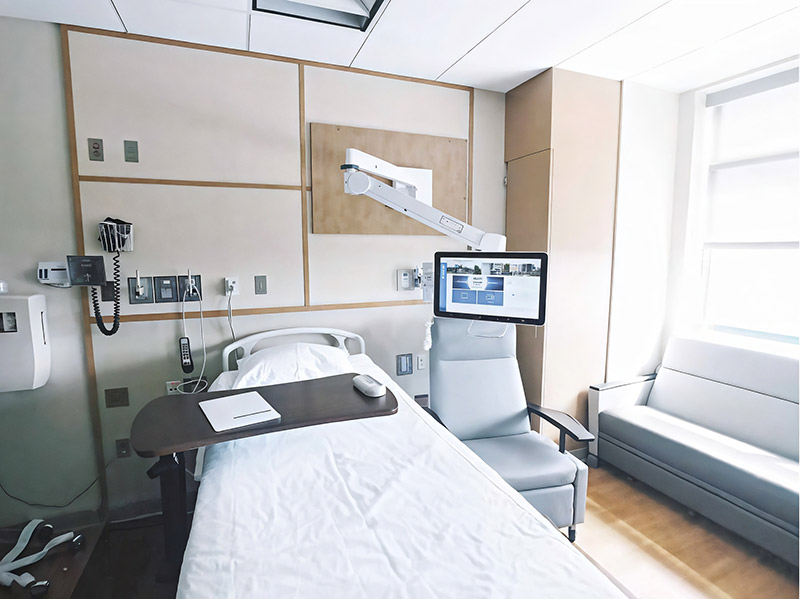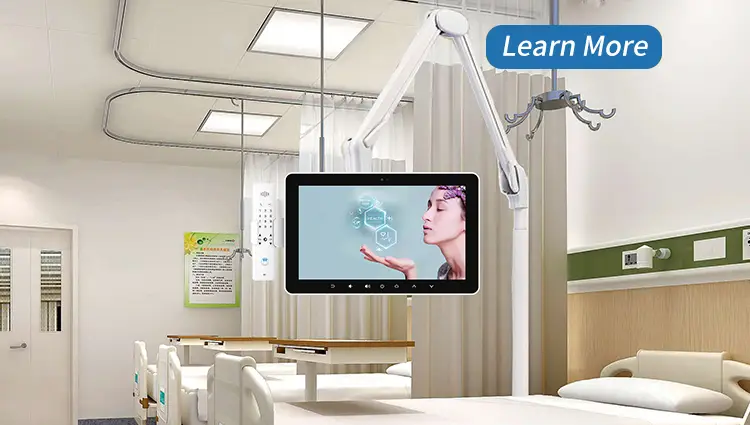Introduction to Hospital Grade TV Media Terminals
In today’s healthcare environment, patient experience and safety are paramount. Enter hospital-grade TV media terminals: specialized systems designed to meet the stringent requirements of medical facilities. These devices go beyond standard TVs by offering antibacterial surfaces, compliance with hygiene protocols, and integrations with patient care software. Whether used for entertainment, education, or telemedicine, these terminals bridge the gap between patient comfort and clinical efficiency.

This guide explores what sets hospital-grade TV media terminals apart, their key applications, and their compliance with safety standards like NSF/ANSI 2 and UL 60601.
Why Hospitals Require Specialized TV Systems
- Infection Control
Hospital TVs face constant exposure to pathogens. Standard screens and remotes can harbor bacteria like MRSA or C. diff, posing contamination risks. Healthcare-certified TVs feature non-porous, antimicrobial coatings (e.g., silver-ion technology) that reduce microbial growth by up to 99.9%. - Durability & Safety
Unlike consumer TVs, hospital-grade terminals are built to withstand daily disinfection using harsh chemicals like bleach. Their reinforced frames, shatterproof screens, and sealed components prevent liquid ingress. - Compliance with Medical Standards
Units must meet certifications such as UL 60601-1 (electrical safety in medical environments) and IEC 60601 (EMI/RFI shielding to avoid interference with medical devices).
Core Features of Medical-Grade TV Terminals
- Antimicrobial Touchpoints
Remotes, buttons, and screens are designed with antimicrobial materials. Brands like Enovate Medical and Lincor use antimicrobial additives in their polystyrene or polycarbonate housings. - HIPAA-Compliant Software
Systems integrate with EHR/EMR platforms, enabling secure access to patient records. HIPAA-compliant communication tools allow confidential telehealth consultations. - Customizable Content Delivery
Administrators can broadcast patient education videos, wayfinding maps, or dietary menus. Solutions like SONIFI Health offer multi-language support and ADA-compliant interfaces. - Energy Efficiency
Most units are ENERGY STAR certified, reducing power consumption by 30-50% compared to commercial models. Automatic sleep modes activate during inactivity.
Applications in Modern Healthcare
- Patient Rooms: Provide on-demand movies, gaming, and video calls to reduce stress.
- Nurse Stations: Display real-time patient vitals from connected devices (e.g., IoT-enabled monitors).
- Operating Rooms: Stream surgical procedures for training or consultations.
- Waiting Areas: Share health tips, clinic updates, or news to improve visitor engagement.
Buying Guide: How to Choose the Right System
- Prioritize Hygiene Certifications
Look for NSF/ANSI 2 (foodservice equipment standard often applied to medical TVs) or ISO 10993 (biocompatibility testing). - Evaluate Mounting Options
Ensure brackets are compatible with hospital beds, walls, or ceiling mounts. Retractable arms (e.g., Ergotron’s MedCart) save space in compact rooms. - Integration Capabilities
Check for HL7 compatibility to sync with EHRs, nurse call systems, or bedside monitors. - Warranty & Service Plans
Opt for vendors offering 5+ years of on-site support and overnight part replacements.
Addressing Common Concerns: FAQs
Q1: Can hospital TVs be used in isolation rooms?
Yes. Many models are rated for use in negative-pressure environments and feature HEPA air filter compatibility.
Q2: Are patient TVs compatible with personal devices?
Most modern terminals support HDMI-CEC, allowing patients to mirror content from smartphones or tablets.
Q3: How do hygiene-focused TVs perform in high-traffic areas?
Industrial-grade screens (e.g., Corning Gorilla Glass) resist scratches, while capacitive touchscreens work with gloved hands.
Q4: What’s the typical lifespan of a hospital-grade TV?
With proper maintenance, these units last 7-10 years – double the lifespan of consumer TVs.
Q5: Can terminals display real-time medication schedules?
Yes. Integration with platforms like Epic MyChart Bedside enables medication alerts and care plan updates.
Industry Trends & Future Innovations
- Touchless Controls: Voice-activated commands (via Amazon Alexa Healthcare or Google Health API) minimize contact.
- AI-Driven Content: Algorithms personalize entertainment or education based on patient demographics.
- Modular Upgrades: Swappable components (e.g., upgraded processors) extend system longevity.
Conclusion
Investing in hospital-grade TV media terminals isn’t just about entertainment – it’s a strategic step toward safer, more efficient patient care. By prioritizing certifications, durability, and software compatibility, facilities can foster a healing environment while complying with evolving healthcare regulations.

